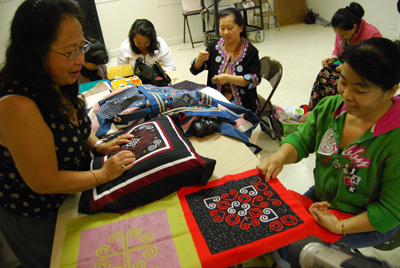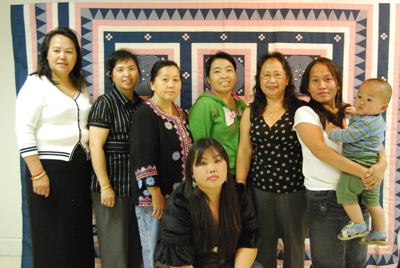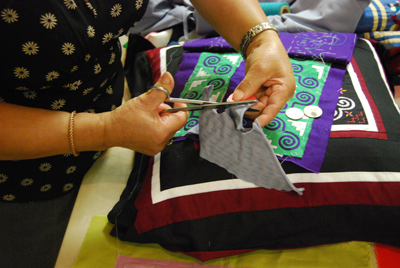 Master artist Ying Yang of Long Beach has been working with apprentice Xong Lee of Riverside in an apprenticeship on Hmong paj ntaub as current participants of ACTA’s Apprenticeship Program. Also known as reverse appliqué embroidery, paj ntaub involves meticulous hand sewing and cutting, resulting in embroidered fabric squares with various combinations of geometric, symbolic designs which can take anywhere from a week to several months to complete, depending on the complexity of design, scale and frequency of work. Paj ntaub has multiple purposes and applications in daily and festive life, used as gifts, funeral cloths, and ornamentation, and, Yang summarizes, is “one of the most important Hmong art forms. We decorate our New Year festival clothes with paj ntaub to show our gratefulness for the good things of the year past and in hopes of good things in the year to come. We decorate baby carriers with paj ntaub to show how we value our beautiful babies. We place paj ntaub with the dead to honor them. The designs show our respect for nature and all the beauty in nature. We create beauty as an important part of living.”
Master artist Ying Yang of Long Beach has been working with apprentice Xong Lee of Riverside in an apprenticeship on Hmong paj ntaub as current participants of ACTA’s Apprenticeship Program. Also known as reverse appliqué embroidery, paj ntaub involves meticulous hand sewing and cutting, resulting in embroidered fabric squares with various combinations of geometric, symbolic designs which can take anywhere from a week to several months to complete, depending on the complexity of design, scale and frequency of work. Paj ntaub has multiple purposes and applications in daily and festive life, used as gifts, funeral cloths, and ornamentation, and, Yang summarizes, is “one of the most important Hmong art forms. We decorate our New Year festival clothes with paj ntaub to show our gratefulness for the good things of the year past and in hopes of good things in the year to come. We decorate baby carriers with paj ntaub to show how we value our beautiful babies. We place paj ntaub with the dead to honor them. The designs show our respect for nature and all the beauty in nature. We create beauty as an important part of living.”
As a young girl growing up in a subsistence farm during the 1960s in a Hmong village in the Louang Prabang province in northern Laos, Yang was first exposed to sewing by women and girls in the village who sewed in the evening after long days of farming. Common practice amongst Hmong girls, her first sewing lessons from her grandmother and mother began when Yang was about seven years-old, making new clothes for the Hmong New Year and decorating the clothing with cross-stitch embroidery. After the withdrawal of covert American support for Hmong guerilla forces, which preceded the Pathet Lao communist takeover of Laos in 1975, vulnerable Hmong families were relocated to Thai refugee camps, where paj ntaub grew into a commercialized form practiced by Hmong women as a means of family survival in Thailand. Despite the commercialization of the form, the tradition itself remains an important part of Hmong culture and identity. It was in a Thai refugee camp where master artist Yang taught herself the form by observing other artists making paj ntaub and practicing over the four years that she, her husband and two children lived in the camp prior to arriving in the United States.
In 1999, Yang was recruited by the Hmong Association of Long Beach—a refugee mutual assistance organization—to lead a women’s Hmong sewing group at the Homeland Cultural Center in Long Beach’s MacArthur Park, concurrent to other Hmong cultural programming which the women’s children would be involved in. The sewing group served as an expansion of the Qeej Not Gangs program which the Hmong Association initiated in the mid-1990s in order to assure the continuity of Hmong cultural traditions in dancing, storytelling, drumming and qeej, particularly amongst Hmong-American youth. Apprentice Xong Lee and her husband have been key supporters to the Qeej Not Gangs program. “We learn every Sunday here,” Lee says about the array of cultural activities Qeej Not Gangs offers. “Children, men, women, they really learn and it keeps the culture together. Even with paj ntaub everyone keeps together. When kids see paj ntaub they know it is their culture.” Lee has been a steadfast participant in the now almost 10-year old sewing group which has occurred in the same room since its inception. Yang describes Lee as “the most interested and the bravest in trying to learn to design and cut.” Their relationship predated the sewing circle, having known each other for over twenty years through their White Hmong families’ mutual involvement in the Hmong Association and preparations for Hmong New Year festivals over the years.
Lee, who grew up in Xieng Khouang province in central Laos, was also raised in a family of farmers but never had the opportunity to practice paj ntaub until after her arrival to Long Beach. “I saw a display of paj ntaub for sale by See Lee at our Long Beach New Year festival. I wanted to buy, but I didn’t have money. I thought maybe I can learn to make my own.” A few years later, Lee joined Yang’s sewing circles, where Lee could practice her needlework under Yang’s guidance.
Going strong with a core group of women, the sewing circles are important to Yang, who has played a role as a cultural leader in her community, displaying her paj ntaub at public venues, cultural festivals and New Years celebrations, and cutting paper paj ntaub for Hmong community events. “If you don’t know how to make paj ntaub, you can’t make traditional outfits. That’s why I continue doing this. Now people are getting more interested in doing this,” Yang reflects.
 The sewing circle also serves as the regular context in which Yang and Lee’s apprenticeship occurs. Because of Yang’s high skill in paj ntaub—which involves layering different colors of fabric cut with designs which are carefully turned under at the edges and sewed in tiny stitches to reveal the designs and the outline of color of the fabric underneath—most of the women in the circle are content to focus on refining their hand sewing and needlework, turning to Yang for the cutting because it is so difficult. Cutting requires a confident, exact hand and fine manipulation of scissors to cloth. Lee was no exception to allowing Yang to prepare cutting for her until a few years ago. Yang explains: “She has been my best and most devoted student, so we started talking about her learning the most difficult part, the designing and cutting, and she has begun cutting. A lot of people know principles of paj ntaub, but not a lot know how to do it well.
The sewing circle also serves as the regular context in which Yang and Lee’s apprenticeship occurs. Because of Yang’s high skill in paj ntaub—which involves layering different colors of fabric cut with designs which are carefully turned under at the edges and sewed in tiny stitches to reveal the designs and the outline of color of the fabric underneath—most of the women in the circle are content to focus on refining their hand sewing and needlework, turning to Yang for the cutting because it is so difficult. Cutting requires a confident, exact hand and fine manipulation of scissors to cloth. Lee was no exception to allowing Yang to prepare cutting for her until a few years ago. Yang explains: “She has been my best and most devoted student, so we started talking about her learning the most difficult part, the designing and cutting, and she has begun cutting. A lot of people know principles of paj ntaub, but not a lot know how to do it well.
“Between us, we have thought about the younger generation. If they don’t learn this, then the tradition will be gone. But if they keep learning, they will keep this forever—from generation to generation—so it would be really great. People don’t wear these traditional clothes anymore—that’s why most young kids are not interested.”
Sewing circle participant Khou Lee, in her twenties, is one of the youngest participants in the group, who shares her perspective on why younger Hmong-American women are less engaged. “Most young people don’t have the patience to sew. Paj ntaub takes time. It is really slow. Paj ntaub is our culture. It’s really nice. That’s why I do it. If you don’t teach this or somebody doesn’t learn, there won’t be paj ntaub. Mostly old people practice paj ntaub. Young people, they go to work or they go to school. They come home and relax. If they want a paj ntaub, they go out and buy it. It is easier.” She continues to comment on Yang’s leadership and the importance in keeping traditions alive in their community: “If people—not just Hmong people—get interested, they hire her to go teach. If [non-Hmong] know how to do it and our Hmong people don’t want to learn, then our culture will die. Other people will know paj ntaub, but it won’t be ours anymore.”
“It is really hard for young people to learn, fold, and sew, so it is easier to buy paj ntaub,” Xong Lee echoes. “When you see that you can do it, that things come out from your hands, it is really interesting. Paj ntaub is the way to tell where you are coming from. Each piece represents something. It’s really nice, that’s why I continue. I won’t put it away because I really like it.”
“I want to teach people so that even when I’m not here, they can teach the next generation,” Yang comments, referring to the women whom she works with, including Lee. “No matter how many people learn, I have to keep teaching. Whoever comes and is interested, I will teach them. I can teach even if it was only one other person.”
 During the course of the apprenticeship, Lee has been working on three different pieces which incorporate traditional symbolic design motifs and arrangements passed down for generations which represent animals leaves, elephant feet, snails, dragon teeth, hearts and other designs, focusing on cross-stitch and lattice work, and moving from straight-lined patterns to the more difficult circular patterns. “I want to learn more cutting and to see how far I can go. I think it is really nice to work with [Yang]. You can ask her what a design means, and she will do it for you. She’s really patient and a really nice person. Ying Yang’s paj ntaub are very beautiful with good designs, perfect stitching and very beautiful color combinations… She is always encouraging.”
During the course of the apprenticeship, Lee has been working on three different pieces which incorporate traditional symbolic design motifs and arrangements passed down for generations which represent animals leaves, elephant feet, snails, dragon teeth, hearts and other designs, focusing on cross-stitch and lattice work, and moving from straight-lined patterns to the more difficult circular patterns. “I want to learn more cutting and to see how far I can go. I think it is really nice to work with [Yang]. You can ask her what a design means, and she will do it for you. She’s really patient and a really nice person. Ying Yang’s paj ntaub are very beautiful with good designs, perfect stitching and very beautiful color combinations… She is always encouraging.”
Yang intends to give more ideas and designs to Lee to challenge her skills. “The cutting is getting smaller, more difficult, more interesting,” Lee says about the apprenticeship, “The ladder I climb, each step will be more difficult, but I keep going.”
Despite the concern of waning interest amongst youth in this demanding art form which requires patience, focus and investment of time, Yang is not discouraged and remains hopeful. “When I observe Xong and the other women progress, I know that making paj ntaub is going farther and deeper. There is real learning. I’m really happy to see that when I teach Xong, she is learning faster, doing better and improving her designs. I am very happy that Xong wants to learn the most difficult parts of sewing paj ntaub. Then she will also be able to teach younger people when they are ready and willing.”
Lee has also observed that slowly, but surely, there is an increase in interest in the form. “I feel the younger generation should learn. They are really busy, but they should have this, they should learn this so we can keep it forever.”
Quotes from Ying Yang interpreted by Kay Yang, Xong Lee and Khou Lee, with support from Karen S. Harper.
